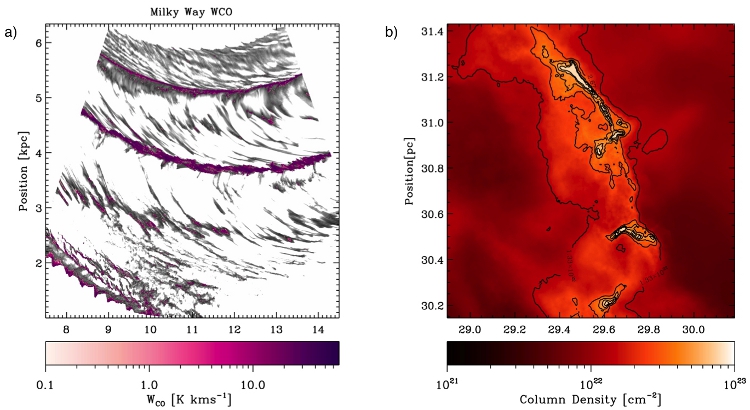| EPoS Contribution |
|
Exploring the filamentary initial conditions of star formation using AREPO
Rowan Smith ZAH/ITA, Heidelberg, DE | |
| In this contribution I will present new simulations of molecular cloud formation in a galactic disc and use the results to examine the initial conditions of star formation. We use the moving mesh code AREPO with time-dependent chemistry to model a section of a spiral disc galaxy down to four solar mass resolution. We find that extremely long "Nessie-like" filamentary molecular clouds are a common feature of such simulations. We compare these filamentary clouds to observations of IRDCs and examine whether environmental dependences such as proximity to a spiral arm affect the density structures within the cloud. We test which filamentary clouds are most likely to go on to produce star-forming cores and which clouds will form dense clusters. Finally, we zoom in to simulate individual clouds and examine how the star-forming filaments within the cloud compare to observed filament profiles. Our simulations are in good agreement with observations, however we find that the observed filament widths are highly dependent on the range of data used to constrain the fit to the central peak. When the full filament column density is fitted a width of 0.3 pc is typically obtained, but when only the central radii are included the width is 0.1 pc. | |
 | |
| Caption: Filamentary structure and Star Formation: a) A simulation of molecular cloud formation in a section of the Milky Way. The simulation has a mass resolution of only 4 solar masses which allows individual clouds to be resolved. It also includes time-dependent chemistry so that we can model the CO emission from the disc. The grey contours show the molecular hydrogen column density and the purple shows the integrated CO emission. Long filamentary "Nessie-like" clouds are a feature of the simulation. b) A smaller scale simulation of the internal filamentary structure in such a molecular cloud. The profiles of our simulated filaments are in good agreement with observation of filaments in nearby molecular clouds. However, the width of the central core of the filament is highly dependent on the radius to which the column density is fitted. | |
| Collaborators: S. Glover, ZAH/ITA Heidelberg, Germany P. Clark, ZAH/ITA Heidelberg, Germany R. Klessen, ZAH/ITA Heidelberg, Germany V. Springel, HITS Heidelberg, Germany |
Suggested Session:
Filaments |

